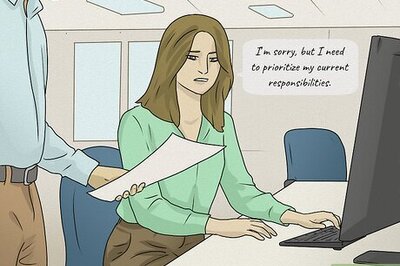
views
WASHINGTON: The explosive surge in U.S. coronavirus cases this fall has left a question hanging: When will the economy take its own turn for the worse?
It may be starting.
Red flags are appearing across a range of high-frequency measures of retail foot traffic, small business hiring and other data, and even previously bullish forecasters are increasingly concerned consumers may buckle in the face of rising health risks.
New COVID-19 cases were being diagnosed at a rate of more than 125,000 per day through early November, six times the level of June. A thousand people a day are dying, and hospitals are reaching capacity in some parts of the country in a replay of the dire early days of the outbreak eight months ago. State and local governments are beginning to impose new restrictions.
Against that grim backdrop, reservations for in-restaurant dining fell for the fourth week in a row, according to data from OpenTable https://www.opentable.com/state-of-industry, while employment at a sample of small businesses also has fallen steadily for a month, according to data from time management firm Homebase https://joinhomebase.com/data.
Jobs in real time https://graphics.reuters.com/USA-ECONOMY/REOPENING/azgvoaggdvd/chart.png
Foot traffic to retail sites has at best remained steady, according to data from cellphone tracking firm Safegraph https://www.safegraph.com/dashboard/covid19-commerce-patterns.
Similar data from Unacast https://www.unacast.com/covid19/covid-19-retail-impact-scoreboard has fallen weekly since early October. According to the company’s latest analysis, only Mississippi has levels of retail traffic above 2019, whereas over the summer roughly half the country had returned to that benchmark.
Retail in real time https://graphics.reuters.com/USA-ECONOMY/REOPEN/xegvbjdrnvq/chart.png
An Oxford http://blog.oxfordeconomics.com/topic/recovery-tracker Economics broad index of the recovery, including economic, social and health data, “is reeling,” said Gregory Daco, chief U.S. economist at Oxford Economics, declining for its fourth straight week and now back to midsummer levels largely on the basis of eroding health conditions. Local indicators fell in 47 states.
NY Fed Weekly Economic Index https://graphics.reuters.com/USA-ECONOMY/WEI/azgpoagodpd/chart.png
The fall months have brought “a visible weakening in the economy as virus infections weighed on markets and mobility. While employment and demand momentum remained positive, both are very close to stall speed,” Daco wrote this week.
DIVERGENT RECOVERY
Some indicators are holding up, and much of the last few weeks has seen a still unresolved tension between monthly macroeconomic data like retail sales and employment that have performed better than expected, while the more novel, high-frequency data sets have shown the recovery stalling or reversing.
An index of job postings from hiring site Indeed https://www.hiringlab.org continues to climb and is now just 13% below 2019 levels, and shift work across a sample of firms and industries rose 1.3% last week, according to data from time management firm UKG https://www.kronos.com/about-us/newsroom/update-us-workforce-activity.
Initial jobless claims, at 709,000 for the week ending Nov. 7, remain astoundingly high, but continue to edge lower. A New York Fed https://www.newyorkfed.org/research/policy/weekly-economic-index#/interactive weekly index of economic growth continues ticking higher.
Oxford Economics Recovery Index https://graphics.reuters.com/USA-ECONOMY/OXFORDINDEX/yzdvxqzmkpx/chart.png
But this remains a divergent recovery. Data from analytics firm Chmura http://www.chmuraecon.com/blog estimates that new job postings have fallen sharply over the last two weeks from around 78% to 66% of their predicted level based on 2019 trends, a sign that future hiring plans are decaying.
The data from Indeed showing a steady climb in job postings back toward 2019 levels masks a separation by sector: Postings for “stocking and loading” jobs are up 26% over last year to staff the boom in home delivery retail, while postings in hospitality and tourism are down nearly 47%.
The overall growth in UKG’s shift counts, similarly, is driven by work at larger firms and healthier sectors like manufacturing. Shift growth is flat at companies with fewer than 500 employees, and has been falling since last month in the retail and hospitality industries.
Goldman Sachs analyst David Choi said the impact of the intensifying COVID-19 outbreak on overall economic activity so far has been “relatively limited,” noting, as have many economists, that businesses, consumers and local governments have changed their spending, job and regulation patterns less during the current surge in cases than before.
But, with holiday gatherings and the winter months still ahead, the already record-breaking wave of infections may still be in its early stages, Choi warned, a notable tone of caution from a team member at Goldman, which has been among the most bullish on a continued recovery.
“The virus resurgence is still in early stages, and we expect significantly worse overall virus spread than the summer,” Choi wrote. “While the data also suggest that voluntary consumer behavior has responded less strongly to increased virus risks during the recent resurgence, this could change should perceived risks increase as case counts, hospitalizations, and fatalities rise.”
Disclaimer: This post has been auto-published from an agency feed without any modifications to the text and has not been reviewed by an editor
Read all the Latest News, Breaking News and Coronavirus News here




















Comments
0 comment